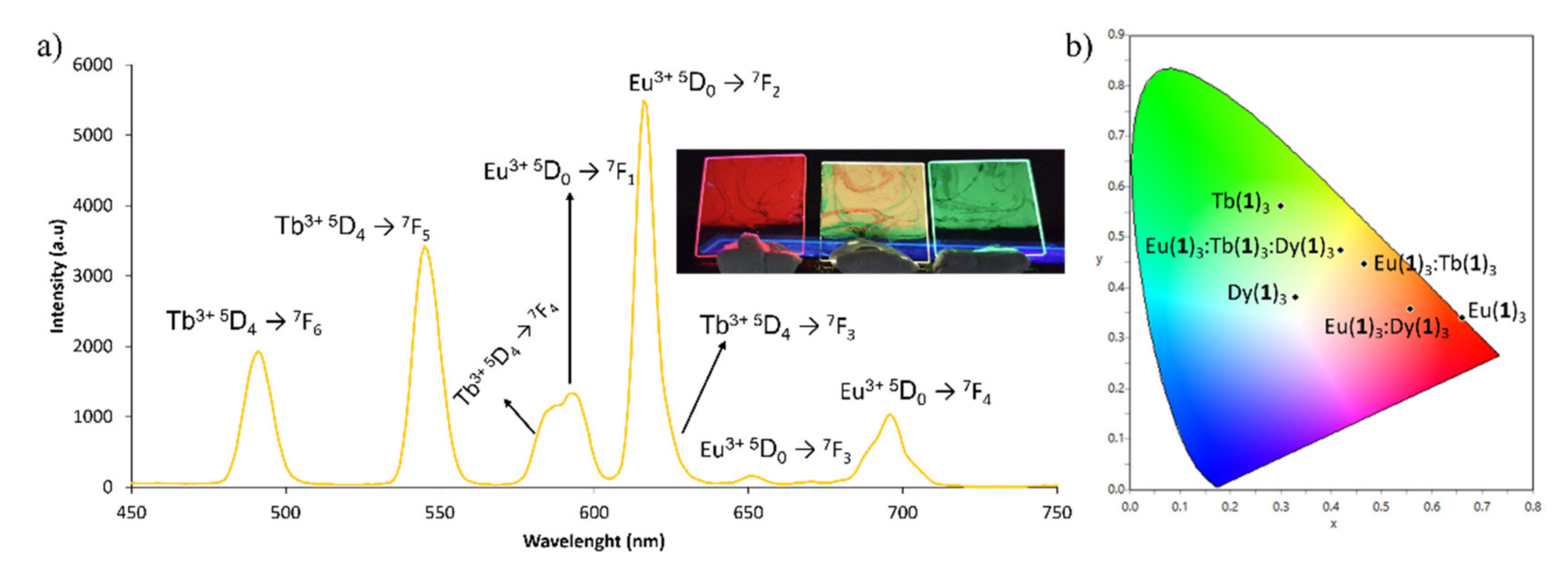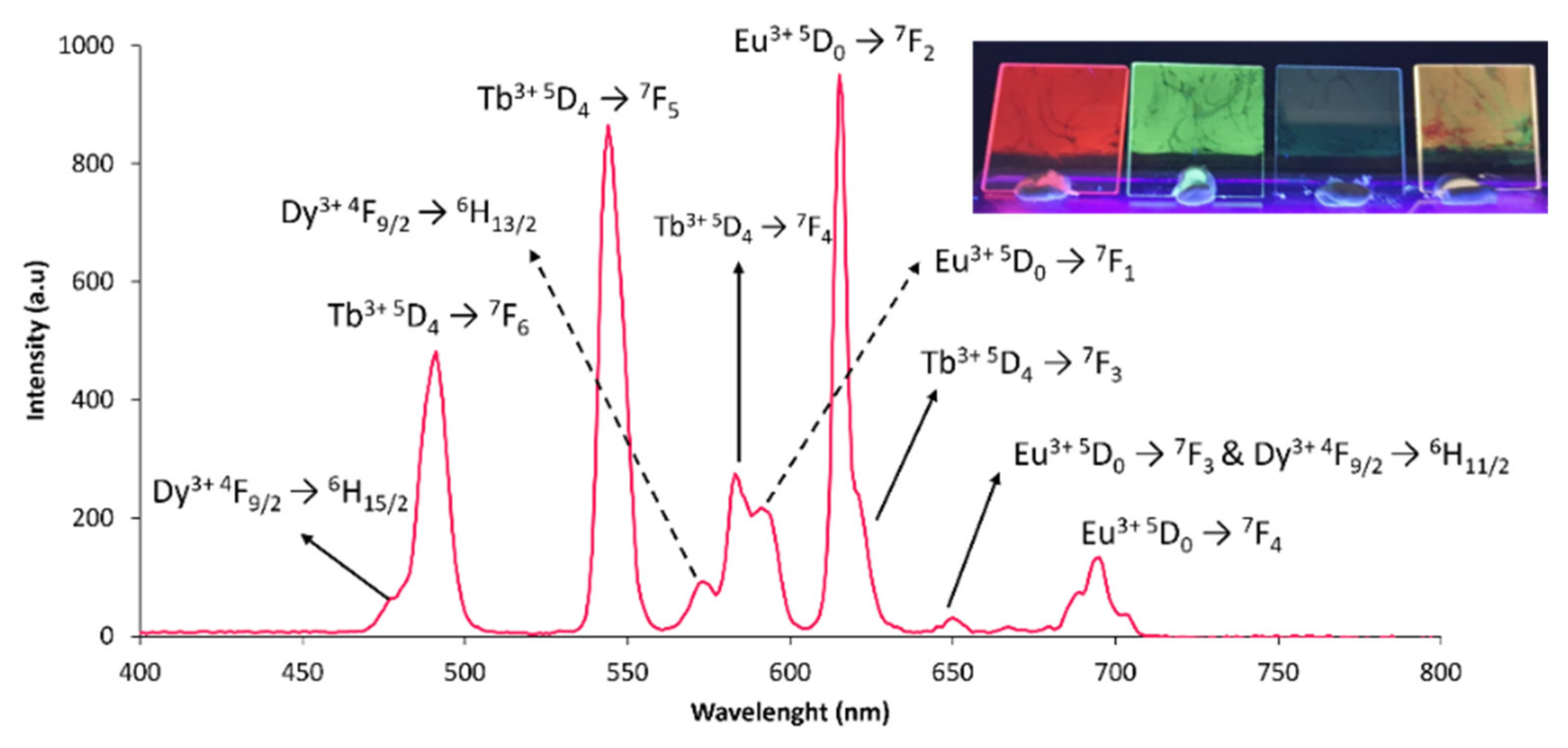Lanthanide-Based Langmuir–Blodgett Multilayers: Multi-Emissive, Temperature-Dependent Thin Films
Abstract
:1. Introduction
2. Materials and Methods
2.1. General Experimental Details
2.2. Multilayer Langmuir–Blodgett Deposition
3. Results
4. Conclusions
Supplementary Materials
Author Contributions
Funding
Institutional Review Board Statement
Informed Consent Statement
Data Availability Statement
Conflicts of Interest
References
- SeethaLekshmi, S.; Ramya, A.R.; Reddy, M.L.P.; Varughese, S. Lanthanide complex-derived white-light emitting solids: A survey on design strategies. J. Photochem. Photobiol. C 2017, 33, 109–131. [Google Scholar] [CrossRef]
- Kukhta, N.A.; Bryce, M.R. Dual emission in purely organic materials for optoelectronic applications. Mater. Horiz. 2021, 8, 33–55. [Google Scholar] [CrossRef] [PubMed]
- Yin, H.-Q.; Yin, X.-B. Multi-Emission from Single Metal–Organic Frameworks under Single Excitation. Small 2022, 18, 2106587. [Google Scholar] [CrossRef] [PubMed]
- Yin, H.-Q.; Yin, X.-B. Metal–Organic Frameworks with Multiple Luminescence Emissions: Designs and Applications. Acc. Chem. Res. 2020, 53, 485–495. [Google Scholar] [CrossRef]
- Bünzli, J.-C.G.; Piguet, C. Taking advantage of luminescent lanthanide ions. Chem. Soc. Rev. 2005, 34, 1048–1077. [Google Scholar] [CrossRef]
- Bünzli, J.-C.G. Rising Stars in Science and Technology: Luminescent Lanthanide Materials. Eur. J. Inorg. Chem. 2017, 2017, 5058–5063. [Google Scholar] [CrossRef] [Green Version]
- Bünzli, J.-C.G. On the design of highly luminescent lanthanide complexes. Coord. Chem. Rev. 2015, 293, 19–47. [Google Scholar] [CrossRef]
- O’Neil, A.T.; Zhang, N.; Harrison, J.A.; Goldup, S.M.; Kitchen, J.A. Synthesis, photophysical and assembly studies of novel luminescent lanthanide(III) complexes of 1,2,3-triazolyl-pyridine-2,6-dicarboxamide-based ligands. Supramol. Chem. 2021, 33, 160–173. [Google Scholar] [CrossRef]
- O’Neil, A.T.; Harrison, J.A.; Kitchen, J.A. Ultra-thin films of amphiphilic lanthanide complexes: Multi-colour emission from molecular monolayers. Chem. Commun. 2021, 57, 8067–8070. [Google Scholar] [CrossRef]
- Amoroso, A.J.; Pope, S.J.A. Using lanthanide ions in molecular bioimaging. Chem. Soc. Rev. 2015, 44, 4723–4742. [Google Scholar] [CrossRef]
- Kido, J.; Okamoto, Y. Organo Lanthanide Metal Complexes for Electroluminescent Materials. Chem. Rev. 2002, 102, 2357–2368. [Google Scholar] [CrossRef] [PubMed]
- Viravaux, C.; Oms, O.; Dolbecq, A.; Nassar, E.; Busson, L.; Mellot-Draznieks, C.; Dessapt, R.; Serier-Brault, H.; Mialane, P. Temperature sensors based on europium polyoxometalate and mesoporous terbium metal–organic framework. J. Mater. Chem. C 2021, 9, 8323–8328. [Google Scholar] [CrossRef]
- Sun, T.; Gao, Y.; Du, Y.; Zhou, L.; Chen, X. Recent Advances in Developing Lanthanide Metal-Organic Frameworks for Ratiometric Fluorescent Sensing. Front. Chem. 2020, 8, 624592. [Google Scholar] [CrossRef] [PubMed]
- Galyametdinov, Y.G.; Krupin, A.S.; Knyazev, A.A. Temperature-Sensitive Chameleon Luminescent Films Based on PMMA Doped with Europium(III) and Terbium(III) Anisometric Complexes. Inorganics 2022, 10, 94. [Google Scholar] [CrossRef]
- Wang, J.; Suffren, Y.; Daiguebonne, C.; Freslon, S.; Bernot, K.; Calvez, G.; Le Pollès, L.; Roiland, C.; Guillou, O. Multi-Emissive Lanthanide-Based Coordination Polymers for Potential Application as Luminescent Bar-Codes. Inorg. Chem. 2019, 58, 2659–2668. [Google Scholar] [CrossRef]
- Hernández-Rodríguez, M.A.; Brites, C.D.S.; Antorrena, G.; Piñol, R.; Cases, R.; Pérez-García, L.; Rodrigues, M.; Plaza, J.A.; Torras, N.; Díez, I.; et al. Lanthanide Luminescence to Mimic Molecular Logic and Computing through Physical Inputs. Adv. Opt. Mater. 2020, 8, 2000312. [Google Scholar] [CrossRef]
- Kotova, O.; Bradberry, S.J.; Savyasachi, A.J.; Gunnlaugsson, T. Recent advances in the development of luminescent lanthanide-based supramolecular polymers and soft materials. Dalton Trans. 2018, 47, 16377–16387. [Google Scholar] [CrossRef]
- Belyi, V.I.; Rastorguev, A.A.; Remova, A.A.; Badmaeva, I.A.; Repinsky, S.M.; Sveshnikova, L.L. Photoluminescence from a system of multimolecular layers of the rare earth metal behenates. Thin Solid Films 2002, 419, 189–193. [Google Scholar] [CrossRef]
- Marets, N.; Kanno, S.; Ogata, S.; Ishii, A.; Kawaguchi, S.; Hasegawa, M. Lanthanide-Oligomeric Brush Films: From Luminescence Properties to Structure Resolution. ACS Omega 2019, 4, 15512–15520. [Google Scholar] [CrossRef] [Green Version]
- Hasegawa, M.; Ishii, A. Thin-film formation for promoting the potential of luminescent lanthanide coordination complexes. Coord. Chem. Rev. 2020, 421, 213458. [Google Scholar] [CrossRef]
- Li, Y.; Xu, Y.; Wang, Y. Preparation and Properties of Transparent Ultrathin Lanthanide-Complex Films. Eur. J. Chem. 2016, 22, 10976–10982. [Google Scholar] [CrossRef] [PubMed]
- Wales, D.J.; Kitchen, J.A. Surface-based molecular self-assembly: Langmuir-Blodgett films of amphiphilic Ln(III) complexes. Chem. Cent. J. 2016, 10, 72. [Google Scholar] [CrossRef] [PubMed] [Green Version]
- Ariga, K. Don’t Forget Langmuir–Blodgett Films 2020: Interfacial Nanoarchitectonics with Molecules, Materials, and Living Objects. Langmuir 2020, 36, 7158–7180. [Google Scholar] [CrossRef]
- McCullough, I.I.I.D.H.; Regen, S.L. Don’t forget Langmuir–Blodgett films. Chem. Commun. 2004, 24, 2787–2791. [Google Scholar] [CrossRef] [PubMed]
- Clemente-León, M.; Coronado, E.; Delhaes, P.; Gómez-García, C.J.; Mingotaud, C. Hybrid Langmuir–Blodgett Films Formed by Alternating Layers of Magnetic Polyoxometalate Clusters and Organic Donor Molecules—Towards the Preparation of Multifunctional Molecular Materials. Adv. Mater. 2001, 13, 574–577. [Google Scholar] [CrossRef]
- Zheng, L.; Wucher, A.; Winograd, N. Chemically alternating langmuir-blodgett thin films as a model for molecular depth profiling by mass spectrometry. J. Am. Soc. Mass. Spectrom. 2008, 19, 96–102. [Google Scholar] [CrossRef] [PubMed] [Green Version]
- Biddle, M.B.; Rickert, S.E.; Lando, J.B.; Laschewsky, A. The use of the Langmuir-Blodgett technique to obtain ultra-thin polar films. Sens. Actuators 1989, 20, 307–313. [Google Scholar] [CrossRef] [Green Version]
- Rocha, J.; Brites, C.D.S.; Carlos, L.D. Lanthanide Organic Framework Luminescent Thermometers. Eur. J. Chem. 2016, 22, 14782–14795. [Google Scholar] [CrossRef]
- Monteiro, B.; Leal, J.P.; Mendes, R.F.; Almeida Paz, F.A.; Linden, A.; Smetana, V.; Mudring, A.V.; Avó, J.; Pereira, C.C.L. Lanthanide-based complexes as efficient physiological temperature sensors. Mater. Chem. Phys. 2022, 277, 125424. [Google Scholar] [CrossRef]
- Hasegawa, Y.; Kitagawa, Y. Thermo-sensitive luminescence of lanthanide complexes, clusters, coordination polymers and metal–organic frameworks with organic photosensitizers. J. Mater. Chem. C 2019, 7, 7494–7511. [Google Scholar] [CrossRef]
- Brites, C.D.S.; Millán, A.; Carlos, L.D. Chapter 281—Lanthanides in Luminescent Thermometry. In Handbook on the Physics and Chemistry of Rare Earths; Jean-Claude, B., Vitalij, K.P., Eds.; Elsevier: Amsterdam, The Netherlands, 2016; Volume 49, pp. 339–427. [Google Scholar]
- Wang, X.-d.; Wolfbeis, O.S.; Meier, R.J. Luminescent probes and sensors for temperature. Chem. Soc. Rev. 2013, 42, 7834–7869. [Google Scholar] [CrossRef] [PubMed]
- Brites, C.D.S.; Balabhadra, S.; Carlos, L.D. Lanthanide-Based Thermometers: At the Cutting-Edge of Luminescence Thermometry. Adc. Opt. Mater. 2019, 7, 1801239. [Google Scholar] [CrossRef] [Green Version]
- Zhao, D.; Rao, X.; Yu, J.; Cui, Y.; Yang, Y.; Qian, G. Design and Synthesis of an MOF Thermometer with High Sensitivity in the Physiological Temperature Range. Inorg. Chem. 2015, 54, 11193–11199. [Google Scholar] [CrossRef]
- Cadiau, A.; Brites, C.D.S.; Costa, P.M.F.J.; Ferreira, R.A.S.; Rocha, J.; Carlos, L.D. Ratiometric Nanothermometer Based on an Emissive Ln3+-Organic Framework. ACS Nano 2013, 7, 7213–7218. [Google Scholar] [CrossRef] [PubMed]
- Zhou, Y.; Yan, B.; Lei, F. Postsynthetic lanthanide functionalization of nanosized metal–organic frameworks for highly sensitive ratiometric luminescent thermometry. Chem. Commun. 2014, 50, 15235–15238. [Google Scholar] [CrossRef] [PubMed] [Green Version]
- LED ColorCalculator (7.77); OSRAM SYLVANIA Inc.: Wilmington, MA, USA, 2022.
- Umemura, Y.; Yamagishi, A.; Schoonheydt, R.; Persoons, A.; De Schryver, F. Langmuir−Blodgett Films of a Clay Mineral and Ruthenium(II) Complexes with a Noncentrosymmetric Structure. J. Am. Chem. Soc. 2002, 124, 992–997. [Google Scholar] [CrossRef] [PubMed]







Publisher’s Note: MDPI stays neutral with regard to jurisdictional claims in published maps and institutional affiliations. |
© 2022 by the authors. Licensee MDPI, Basel, Switzerland. This article is an open access article distributed under the terms and conditions of the Creative Commons Attribution (CC BY) license (https://creativecommons.org/licenses/by/4.0/).
Share and Cite
O’Neil, A.T.; Kitchen, J.A. Lanthanide-Based Langmuir–Blodgett Multilayers: Multi-Emissive, Temperature-Dependent Thin Films. Chemistry 2022, 4, 1457-1465. https://doi.org/10.3390/chemistry4040096
O’Neil AT, Kitchen JA. Lanthanide-Based Langmuir–Blodgett Multilayers: Multi-Emissive, Temperature-Dependent Thin Films. Chemistry. 2022; 4(4):1457-1465. https://doi.org/10.3390/chemistry4040096
Chicago/Turabian StyleO’Neil, Alex T., and Jonathan A. Kitchen. 2022. "Lanthanide-Based Langmuir–Blodgett Multilayers: Multi-Emissive, Temperature-Dependent Thin Films" Chemistry 4, no. 4: 1457-1465. https://doi.org/10.3390/chemistry4040096
APA StyleO’Neil, A. T., & Kitchen, J. A. (2022). Lanthanide-Based Langmuir–Blodgett Multilayers: Multi-Emissive, Temperature-Dependent Thin Films. Chemistry, 4(4), 1457-1465. https://doi.org/10.3390/chemistry4040096






